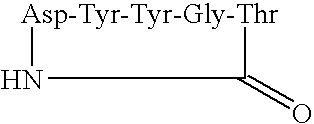Binding moieties for fibrin
a technology of fibrin and binding moieties, applied in the direction of drug compositions, magnetic variable regulation, process and machine control, etc., can solve the problems of stress and destruction of red blood cells, and achieve the effects of excellent thrombus specific imaging agents, effective detection and diagnosis of thrombi, and effective treatment of thrombus associated diseases
- Summary
- Abstract
- Description
- Claims
- Application Information
AI Technical Summary
Benefits of technology
Problems solved by technology
Method used
Image
Examples
example 1
Preparation of a Fibrin Target for Library Screening
[0272] For screening libraries to isolate binding moieties for fibrin, two fibrin targets, i.e., synthetic fibrin clots and then a soluble fibrin fragment, DD(E), were prepared. To prepare fibrin for screening, dilute fibrin clots were formed in the wells of a 96-well plate, dried down to a thin layer, and then rehydrated prior to library screening. In a typical procedure, a 0.15 mg / ml fibrinogen solution was prepared in TBS buffer (50 mM Tris, 150 mM NaCl, pH 7.4). A solution containing 2 U / ml thrombin, 10 mM CaCl2, and 5 mM ε-aminocaproic acid in TBS was prepared. The fibrinogen solution and thrombin solution were mixed 1:1 in the wells of a 96-well plate, aliquoting 25 μL of each solution in each well (total volume=50 μL). The plates were evaporated to dryness by incubating them at 37° C. overnight. Just before a phage library was added to the dried fibrin target, the fibrin wells were washed three times for 10 minutes with pha...
example 2
Screening of Phage Display Libraries
[0275] The TN7 phage library displaying variegated exogenous single-loop peptides based on a polypeptide template having the structure Xaa-Xaa-Cys-Xaa-Xaa-Xaa-Xaa-Xaa-Cys-Xaa-Xaa (SEQ ID NO: 30) (5×109 peptide diversity displayed on M13 phage) was diluted into 100 μL of binding buffer (50 mM Tris, 150 mM NaCl, 2 mM CaCl2, 0.05% Tween-20).
[0276] Before selecting phage that bound to the fibrin or DD(E) targets, at the beginning of each screening round, the libraries were depleted of fibrinogen binders: Fibrinogen was biotinylated by the same method employed for DD(E) biotinylation, and immobilized on magnetic beads. The beads were aliquoted into five tubes. The phage library was incubated with the beads in the first tube for 10 minutes, the beads were pelleted with a magnet, and the supernatant, now at least partially depleted of fibrinogen binding phage, was transferred to a second tube. This process was repeated over the five tubes, and after th...
example 3
Analysis of Individual Isolates
[0277] After five rounds of selection, the eluted phage were propagated and a portion plated to isolate phage plaques arising from individual clones. Ninety such clones were selected randomly, propagated, and tested individually for binding to fibrin in a dried fibrin plate assay. Dried fibrin plates were prepared as described above for the library screening. Phage samples (˜109 phage each) were incubated in the dried fibrin plate wells in binding buffer (50 mM Tris, 150 mM NaCl, 2 mM CaCl2, 0.05% Tween-20) containing 0.1% HSA. After 1 hour, the plates were washed 5 times with binding buffer. Anti-M13 antibody conjugated to horseradish peroxidase (Pharmacia) was added at 1 / 5000 dilution in binding buffer to the wells and incubated with the fibrin for 1 hour. The wells were again washed 5 times with binding buffer and the presence of the antibody / phage / fibrin complex was measured with HRP calorimetric reagents (3,3′,5,5′-tetrarnethylbenzidine (TMB) and...
PUM
| Property | Measurement | Unit |
|---|---|---|
| molecular weight | aaaaa | aaaaa |
| molecular weight | aaaaa | aaaaa |
| atomic numbers | aaaaa | aaaaa |
Abstract
Description
Claims
Application Information
 Login to View More
Login to View More - R&D
- Intellectual Property
- Life Sciences
- Materials
- Tech Scout
- Unparalleled Data Quality
- Higher Quality Content
- 60% Fewer Hallucinations
Browse by: Latest US Patents, China's latest patents, Technical Efficacy Thesaurus, Application Domain, Technology Topic, Popular Technical Reports.
© 2025 PatSnap. All rights reserved.Legal|Privacy policy|Modern Slavery Act Transparency Statement|Sitemap|About US| Contact US: help@patsnap.com



